Well after much debate with myself and preparation I'm finally off and running. Flash back nearly 10 years ago when I bought some of my first auto/petroliana related items, a couple of these tins were among the first purchases I ever made. You may ask why and I can only respond with that they have their charms. In the beginning I wasn't a "specialized" collector as of yet. That's kind of a funny term really.....I consider myself a can collector but I have some globes, a pump in mid restoration, a number of signs, and a various other odds and ends all adding up to a generalized collection. I know many of you can relate to this dilemma. Well, we're getting off track here. As I stated, they have their charms and at the time, their small size was helpful and I liked some of the graphics they offered. I'll admit, they seemed like a very limited potential but as time goes by I keep slowly coming across new one's and Ebay (like it, hate it) has been the biggest source of my aquisitions. As of today the collection now totals 61 pieces with a number of documented pieces that I have yet to attain. Price has always made these attractive as well. Agreed, these are more of a niche collectible so the numbers of collectors are much smaller than the main stream items so prices aren't in the stratosphere realted to supply and demand pressures. Budget minded people can easily put together 20 or so tins and not spend more than a couple hundred. Prices can range from a couple of bucks for average regular pieces to over a hundred for the more limited, in demand tins making for some challenges.
Now the reasons behind my contribution to the hobby. I think it's fair to say that most collectors have one or two of these in their collections but most people don't see these as a serious collectible and for reason. Generally you see the same typical one's time and a again which gives the impression of few choices. After some time looking at these, I began to notice changes in evolutionary graphics as well as the number of different sources for them. I've realized that there is no literature of any kind on them as a resource for collecting. I've noticed ways in which these are sold making them incorrect or dates put to them which is all over the map and nothing that guides people properly without the mistakes that I've made. Let's face it, no matter what level you collect at, spending money on something that is wrong or incorrect puts us all in a foul mood. At some point, I thought it would be neat to compile some kind of history and pictorial giving collectors the knowlege to be better, more focused with their purchases and selections. I always thought this would all converge into a small book or pamphlet but it was never my intention to make any money from such an adventure. Not that there's anything wrong with that. There's a number of books on the hobby and their authors deserve credit for a lot of work. I want to make a contribution for all those that have helped me over the years and maybe create more interest in this wonderful hobby of petroliana. So please, if for nothing else, take the time view this little labor of love of mine and learn about something new. I'll gladly entertain any questions and answer them to the best of my ability. I'm not an expert by any means, so I welcome new information which I hope will make this an evolving guide. Any new undocumented tins that you may have even variations, will be welcome additions. I have nearly 200 pictures to put on here for the purpose of thorough documentation and identification which is crucial for any collector to be informed. When I finally reach the end of my initial presentation, I will be asking for individuals to load photos in a section of displays and advertising to which I know there are some truely remarkable items in collections from the current membership. I've never had the means to focus on all these items so I look for help to make this thread truely complete to my original hopes, dreams, and ambitions.
As stated before, I'm not an expert but if have spent a fair amount of time doing research and countless hours searching the web to dead ends trying to piece together a history. What I found was a "backdoor" aproach through the light bulbs themselves was more helpful. I guess packaging was just that....packaging. SO......you piece things together the best way you can. I'll start with a light history/break down and split things up into chapters so to speak to group "like" things together into sections.
My current collection. A picture to break up all the reading and show the potential that I've realized. When I made the shelf unit, I made it thinking I had room to expand to the "maximum". As you can see it's full and I have many others to obtain yet.
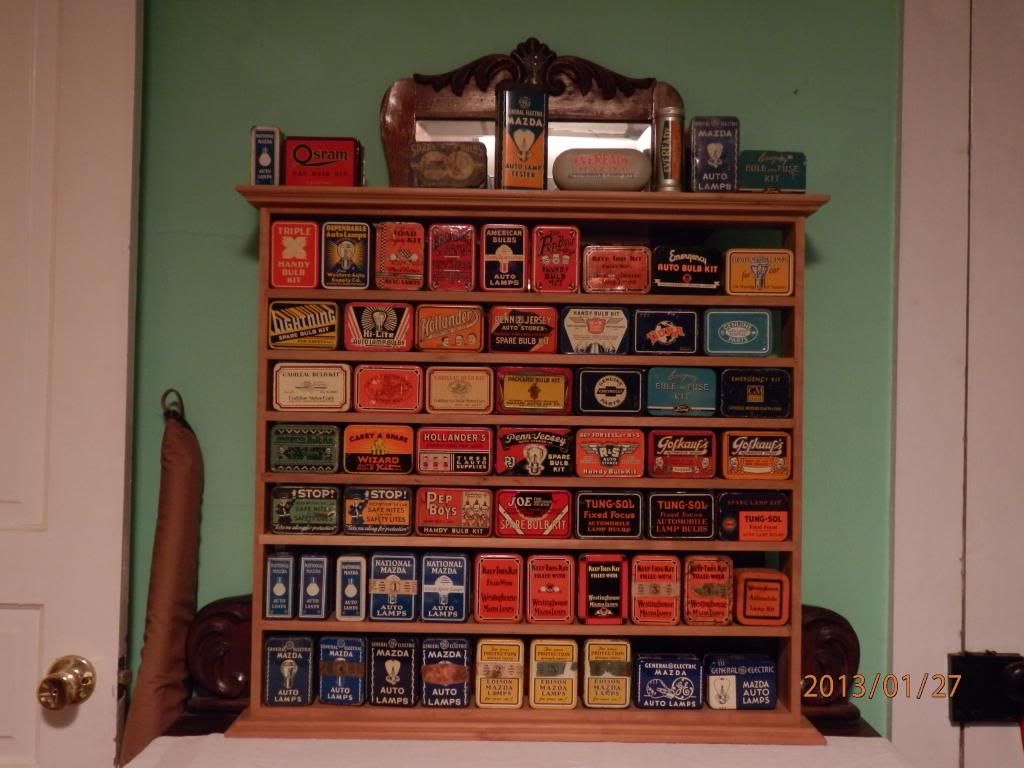
Prior to the age of the tins we are talking about, light bulbs were generally found in a stamped steel presentation such as this one by GE National.
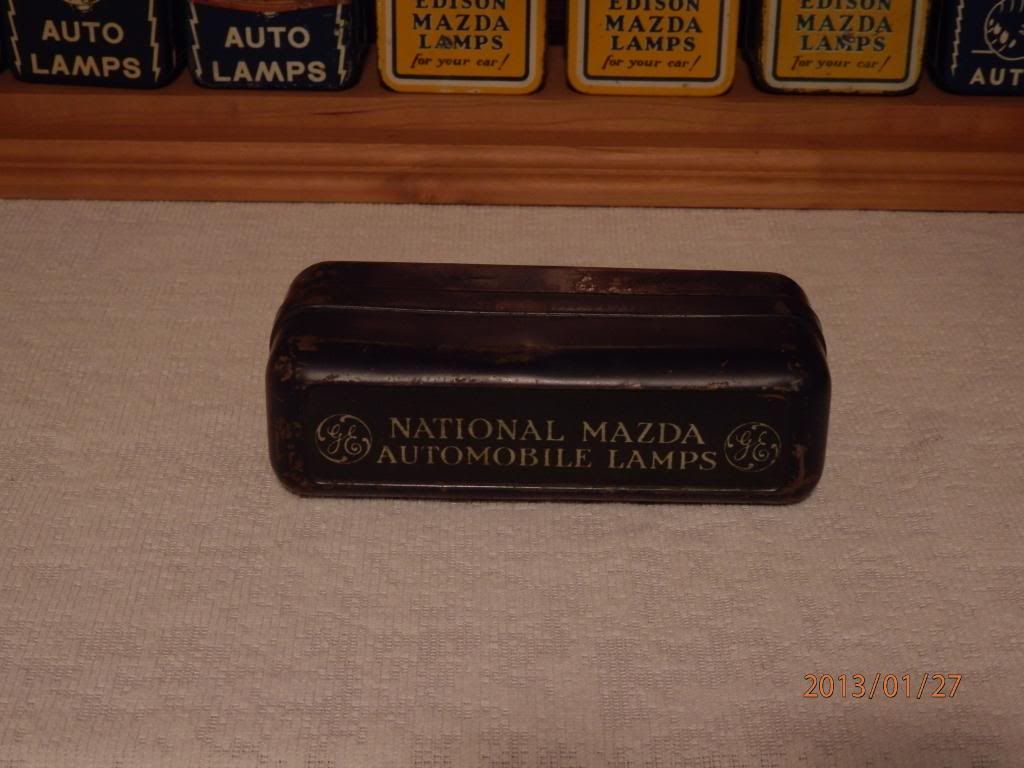
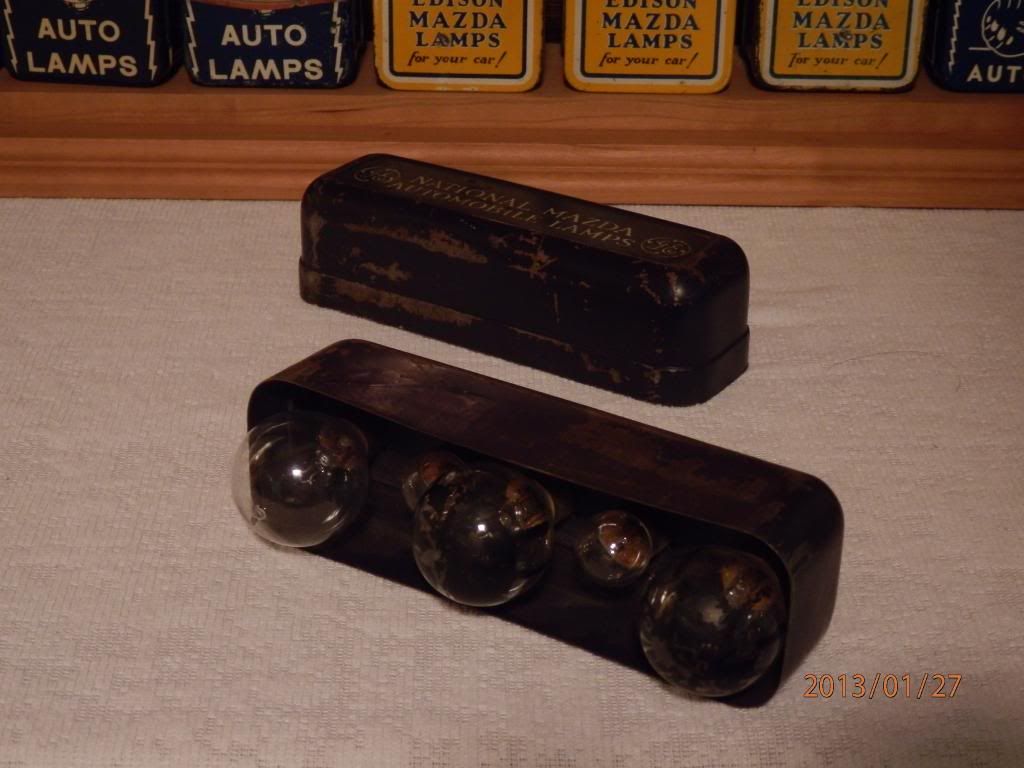
Before this, bulbs from across different, or even within manufacturers, were not very universal in terms of light intensity, materials, and manufacturing standards. GE introduced the "MAZDA" bulb or lamp with a patent date of 1909 with the name Mazda chosen in refernce to a god of mythology named Ahuru Mazda, god of light. The mazda bulb was universal for all bulbs made under a new set of standrds developed by GE using a Tungsten filament which was more uniform from light to light. GE introduced a set of manufacturing specifications for the industry to follow thereby "universalizing" the bulb industry. GE licensed these standards to other manufacturers with GE heavily advetising the Mazda brand. The earliest patent dates I find for automobile lights is patent number 1,082,933 Dec. 30, 1913. Remember, this new standard described the base, filament, manufacturing processes and light intensities giving consumers a higher degree of confidence in bulbs for home, office, or auto as long as it was a Mazda name. GE even regulated the use of the Mazda name. If working was descriptive such as Whiter, it was placed in front of Mazda. If it related to bulb use such as auto, then it must follow the Mazda name. When the change to the new tins took place exactly, is something I can't seem to nail to a specific date. I can tell you through the auto industry, evidence suggests that as early as 1929 these tins were in use. Some help from car enthusiasts verify catalog listings from 1932 and dealer listings show 1931 as an available accessory earliest time frame. Basic tool kit accessories show listings until 1949 which is also verified from Harley Davidson enthusiasts showing one kit as a part of a kit pack through the war years. As a conclusion, I always accept 1929 through 1949 as the known high tide of production. There may be a time period before earlier or later they were in production, but this was on the low scale end as the 1950's began the era of the sealed beam head lamp. It is my understanding, that the earliest of these bulbs had a series of rib-like circular shapes out near the top of the bulbs to help concentrate the light toward the reflectors from proper beam alignment. I cannot verify this concretely however.
Sizes of these tins are generally of the samller 3 5/8L x 2 9/16W x 1 3/4H in inches variety. There is a larger sized kit which is 4 1/6 x 2 9/16 x 2 1/4. Among these 2 most common sizes there are also some exceptions.
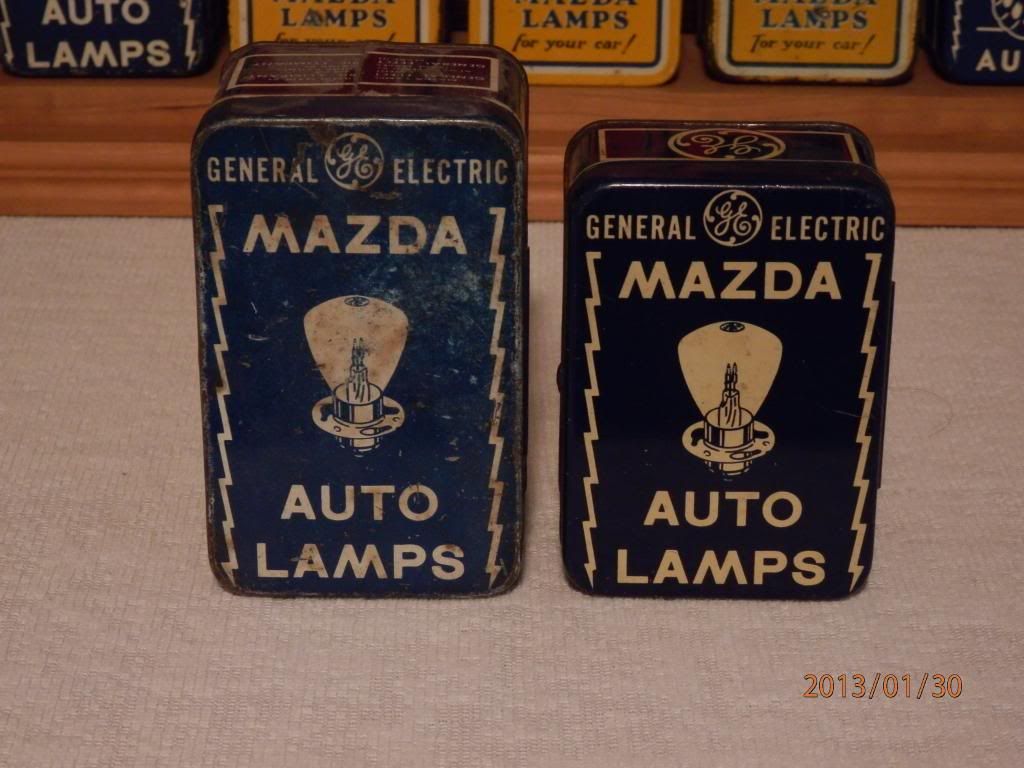
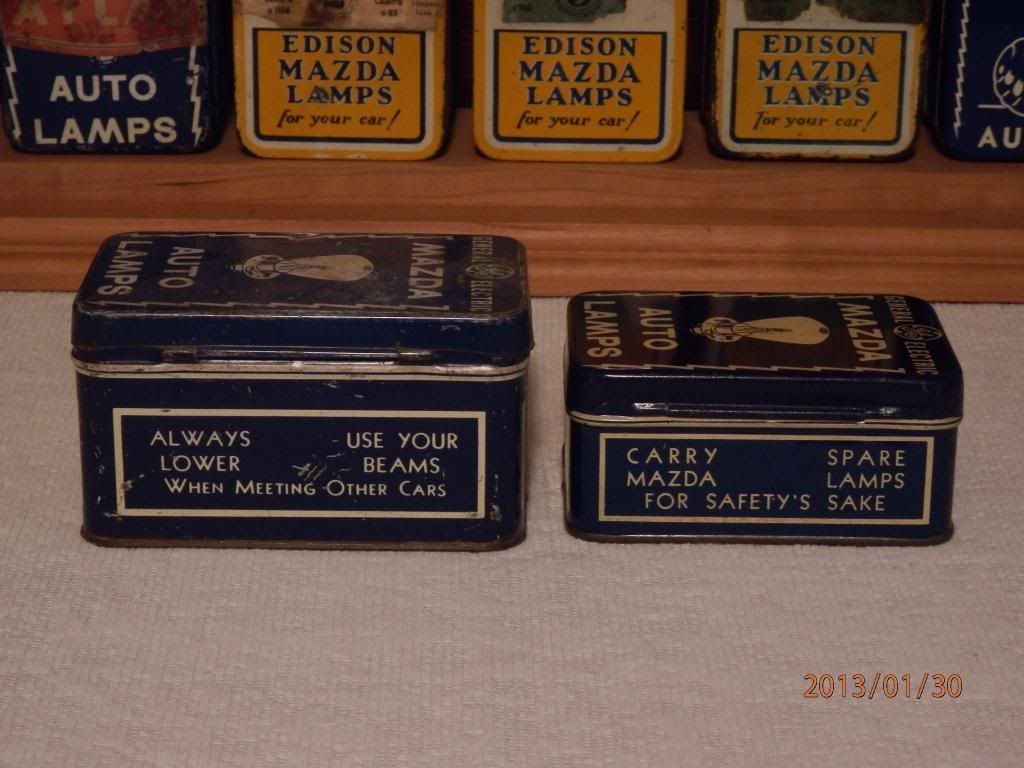
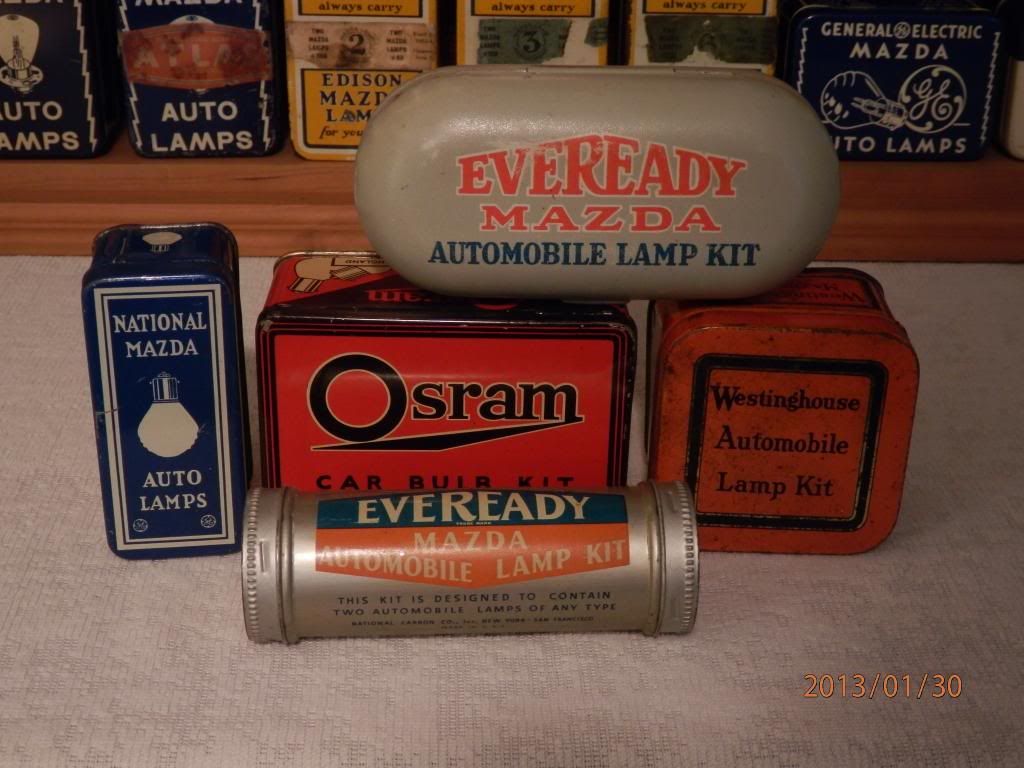
The 2 basic styles of all square tins to date are hinged or unhinged.
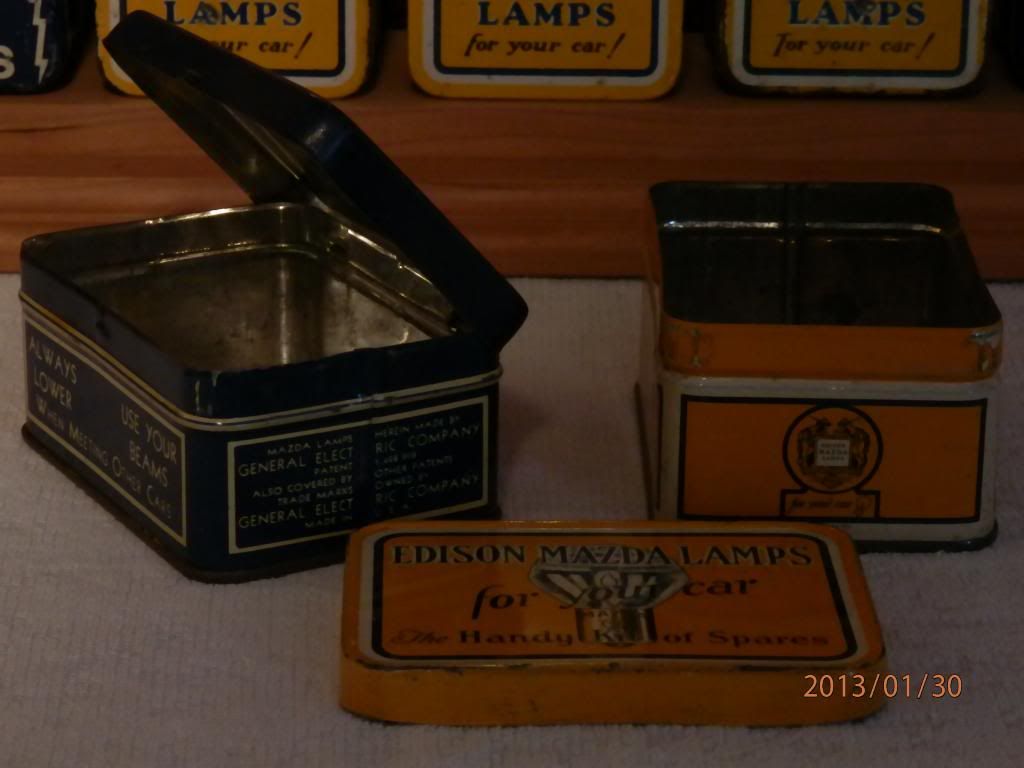
I believe we'll end this section here and I will move on the next section in a day or 2.

